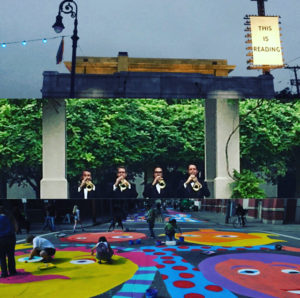
When Doug McLennan asked me to write a description for my blog that ArtsJournal would begin hosting in 2017, I thought about the topics which move me to spend time writing—the things that I feel sufficient passion to write about without compensation. There’s no employer, no client, no contract, and no deadline.
Looking at the writing I’d been doing for my own blog at margyartgrrl and my site on Medium, I concluded that I would:
….focus on the ways we work with others to achieve shared goals, and building understanding that the arts are a valued public good by shifting the way we communicate. And I [will] call it out when we miss opportunities to enhance quality of life, or talk in ways that trigger thinking of the arts as something for others.
Reviewing what happened on The Bright Ride in 2017, it looks like I predicted pretty well.
The three posts of 2017 with the most views reflect my interests: communications, presentation, and creative placemaking—when residents and artists work together toward community goals.
How we talk about the arts (in ways that build broad support)
#3 is my repost of some writing I did when the new administration announced its intention to eliminate a primary federal arts funding stream: How to Talk about Saving the NEA:
Our messages can build support by reminding people that they value the way the arts strengthen places and bring people together. The vast majority of people see these outcomes as reasons we all share responsibility for the arts, even those who don’t think of themselves as ‘goers’.
Advocates often use a different version of value, one based on the ‘return on investment’ that uses a dollars-and-cents case for funding. While it’s true that some decision-makers expect to see this economic impact data, our research reveals that it is not persuasive to the public and is not useful to build broad support for public funding.
How we present the arts (in ways that make people want more)
#2 is one of four posts in 2017 about what makes classical music concerts compelling. I didn’t expect to write about this topic so much—but I am a symphony kid. Both of my parents played in the Cincinnati Symphony, and the Opera, and for the Ballet, and (Dad) at Aspen Music Festival, and (Mom) at Carmel Bach Festival.
I learned a lot from my parents about sharing beauty and music–and their experiences inform my ideas about making classical concerts more broadly appealing (since hardly anyone actually goes). This post is my report on a surprisingly fresh presentation by one of the nation’s oldest music organizations: Deleting the Formal at Classical Concerts.
There were no grand entrances. No pause for applause.
The lights went down and the concert just started.
Dramatic! Not formal. Just the music.
Why don’t more classical music producers do it this way? Stiff entrances and polite applause are tradition, but they suck energy from the show at the very start, unnecessarily delaying access to the main thing. They make the show feel stale.
How artists and neighbors design places (in ways that promote equity and connection)
The number one (by a lot) most popular post of 2017 on The Bright Ride is my insufficient attempt to share the most powerful art I saw all year—by far. This is Reading is the best example of creative placemaking I’ve seen—EVER. Lynn Nottage and her team of artists: actors, dancers, videographers, scene-makers, and the people of Reading Pennsylvania built a show that honored the place, its history, its longtime and new residents, and told a story that inspired future planning by the people who call Reading home.
What makes the magic? The artist collaborators went deep into the city. The people of Reading told their own stories. The artists turned those stories into this authentic and hopeful experience. They did what only artists can do. THIS is creative placemaking. THIS THIS THIS is the real deal.
The words of the people of the city are beautifully and authentically shared in so many media. Every single aspect is jaw-droppingly beautifully rendered….The audience of mostly Reading residents is so proud to be there, smiling, pointing, talking. The producers made sure that residents got tickets, delivering them in person to people they were afraid might not learn of the show through traditional marketing. All of the tickets were free. When the first two weekends of six shows sold out quickly, they extended the show for a third weekend. The whole audience dances together with the artists at the end of the show.
The facts about Reading are hard. These stories of Reading are magically uplifting and joyous.
2017 slapped hard. Still, artists continue to lift and connect us. We celebrate this.
Most Read—2017
#1 This is Reading—Artists Make Magic
#2 Deleting the Formal at Classical Concerts
#3 How to Talk about Saving the NEA

Brava, Margy!